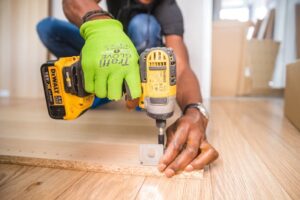
Regular maintenance is a major responsibility of owning a home. While many homeowners forego regular maintenance, thinking they are saving money, the fact is regular home maintenance is what will save them money in the long run. Furthermore, regular maintenance is your first defense mechanism in protecting your most important asset, your property. Here’s a quick checklist of simple house maintenance tasks to help you avoid costly and significant repairs.
1. Keep Tabs on Your Roofing
A roof replacement will cost thousands of dollars, but simple repairs and regular upkeep will be less expensive. You should undertake a visual inspection of your roof twice a year. Look for loose or missing shingles, as well as any discolored or displaced regions. It’s also a good idea to inspect your attic for any signs of a leak – moist spots on ceilings or walls are a major red flag.
Hire a reputable roofing contractor to perform a more thorough examination every five years. It’s also worth hiring a professional to inspect your property after extreme weather, such as heavy snow or rain, or before potentially hazardous circumstances, such as hurricane season.
2. Clean Your Gutters
Gutter overflow is more than just an eyesore. Debris such as leaves, sticks, and pine straw hinder water from flowing away from your home’s walls and foundation. This might result in foundation damage or water infiltrating your basement.
Perform a visual examination on your own from time to time. It’s also a good idea to schedule frequent gutter cleanings, perhaps a couple of times every autumn and periodically throughout the year, based on the vegetation around your property.
3. Inspect Your Plumbing
Plumbing difficulties are a significant concern for homeowners due to the high expense and inconveniences of a leakage or sewage backlog. On a less severe financial level, leaking pipes or faucets can be a significant water waster, costing you money over time.
You may buy water- or mold-monitoring devices that notify you if there is a problem. It’s a good idea to hire a certified plumber to look for leaks and ensure that your sewage pipes are clear. You should schedule a professional plumbing inspection every two years.
4. Maintain Your HVAC Unit
Regular HVAC tune-ups are worthwhile if you want to prevent costly failures in the midst of a sweltering heat wave or a bitter winter snap. Aside from keeping you comfortable and preventing costly delays and emergency repairs, yearly or biannually HVAC system maintenance may assist cut energy expenses and lengthen equipment life. Most importantly, you can safeguard the health and safety of your family.
5. Inspect for Termite Damage
Termite damage may be a severe issue for your property. In most situations, a simple visual check will reveal early indicators of deterioration. Examine your home for wood dust or damage to the wood, particularly windows and exterior walls where termites could have entered. To genuinely thoroughly inspect, use a magnifying glass.
Every wood-frame structure you have should have termite protection plans. You can seek help from a long beach termite inspection professional or research one in your area. During the inspection, a professional will look in and around your house for telltale indications of termite damage and place deterrents that make your property unappealing to those unwelcome invaders.
6. Inspect Your Siding
Your Home’s siding is crucial because it protects it from threats while enhancing curb appeal. Water can seep through damaged wooden, vinyl, or aluminum siding, resulting in bug infestations, rot, mildew, and interior damage. Individual siding repairs are cheap and simple, but rebuilding the whole square footage can be pricey.
Having said that, you should constantly inspect your siding for cracks or holes, as well as missing caulking around windows and doors. Identifying these issues early can save you hundreds of dollars in expensive repairs.
7. Clean Your Chimney
If you use a fireplace to keep your house warm in the cold season, your chimney will need to be inspected on a regular basis. You may perform an eye examination, checking for damaged bricks and fractures. If you notice any abnormalities, this might indicate harm.
Because chimneys may be tricky to manage, it’s best to hire an expert to help you. During the maintenance visit, the chimney professional will clean your structure to clear any built-up creosote and may apply caulking to avoid future water leakage from rain and snow. You should schedule a professional chimney inspection at least once annually.
Closing Thoughts
As a homeowner, you must be proactive in order to safeguard your property. Overlooking preventative maintenance simply leads to higher repair costs.


